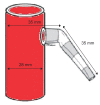Penetrating Atherosclerotic Ulcers of the Abdominal Aorta: A Case Report and Review of the Literature
- PMID: 31620401
- PMCID: PMC6774427
- DOI: 10.5758/vsi.2019.35.3.152
Penetrating Atherosclerotic Ulcers of the Abdominal Aorta: A Case Report and Review of the Literature
Abstract
Penetrating atherosclerotic ulcers (PAUs) of the aorta are defined as atherosclerotic lesions with aortic intima and media ulceration, which may lead to a complete rupture of the adventitial wall. The present article aimed to report an unusual case of a surgically treated patient with abdominal aorta PAU with an illustration of the key features and to review and analyze the existing literature data. PAUs typically develop in elderly and hypertensive patients and in patients with advanced atherosclerosis. Although originally described for the descending thoracic aorta, a similar clinicopathological entity also occurs in the abdominal aorta. Patients with symptoms of a PAU should be treated immediately if they are fit for surgery. Exceptive observation by imaging modalities is necessary in patients with asymptomatic small (<2 cm) PAU, with or without focal dissection.
Keywords: Abdominal aorta; Acute aortic syndrome; Penetrating atherosclerotic ulcer.
Copyright © 2019, The Korean Society for Vascular Surgery.
Conflict of interest statement
CONFLICTS OF INTEREST The authors have nothing to disclose.
Figures





References
-
- Shennan T. Dissecting aneurysms. London: His Majesty’s Stationery Office; 1934.
Publication types
LinkOut - more resources
Full Text Sources

